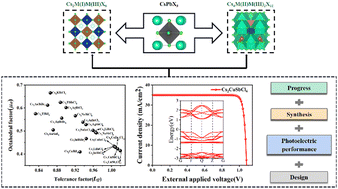Lead-free all-inorganic halide double perovskite materials for optoelectronic applications: progress, performance and design
Abstract
The certified power conversion efficiency of perovskite solar cells is gradually approaching that of crystalline silicon solar cells. Accordingly, considering the advantages of improved thermal stability and environmental friendliness of lead-free all-inorganic halide double perovskites (LFAIHDPs), they have attracted considerable attention in optoelectronic applications. Herein, we review the recent progress on LFAIHDPs via heterovalent substitution of the lead element, including their geometrical and electronic structures, synthetic processes, and applications in optoelectronic devices. Many experimental and theoretical efforts have been devoted to investigating the thermal stability, defects, and optoelectronic properties of lead-free all-inorganic halide double perovskite materials, which have been presented. Lastly, we discuss the application of machine learning strategies to predict novel perovskite structures with excellent thermal stability and optoelectronic performance.

- This article is part of the themed collection: PCCP Reviews


 Please wait while we load your content...
Please wait while we load your content...